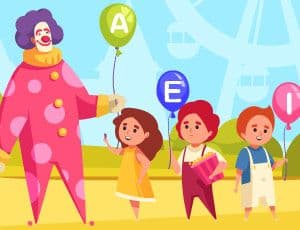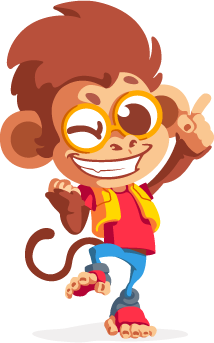Escola Games | Jogos Educativos
https://www.escolagames.com.br
Teacher's support sheet

Playing with the Vowels
Do you know all the vowels? We are going to play with them at this fun game. Let’s help Clint the Clown decorate the circus ring. Complete the words with the correct vowels and then pop the balloons with them. It is time to learn and have fun!

Teacher's tips
Level of Education: Preschool
Subject: English
Theme: Reading and writing - Orality - Literacy
Age: 04 to 06 years old
Interactive games are a great way to teach because they stimulate kids and allow them to understand the topic easily. This method brings together the major needs of the learning process, helping students understand and reproduce the words correctly. In this game, kids will learn the vowels and how they are written and pronounced, providing a playful and meaningful learning process. [FIM-DICA]
Learner outcomes
To develop reading skills;
To associate the vowels with their sound;
To differentiate consonants from vowels;
To understand that different words share certain letters;
To distinguish letters from numbers and geometric shapes;
To reinforce content discussed during the classes.
Teachers' goals
To enable the acquisition of skills and competencies essential to the construction of children's reading and writing processes;
To offer a playful and pleasurable proposal that allows the student to associate the letters with their spelling and sounds;
To stimulate students to identify different colors;
To offer the game as a didactic resource to explore the content discussed in the classroom;
To expand students' knowledge.
Suggestions of approaches for the teacher
Separate students in pairs and ask them to take turns clicking the vowels.
Stimulate students to read the words according to the images and ask them to copy each on their notebooks.
Then, use those words and ask them to read and illustrate them. If a student struggles with reading some words, ask their classmates to help.
Design materials so students can check when they have questions. Invite them to build a dictionary with those words and put them on the wall. All the words must come with illustrations so kids identify and memorize the words. It is essential to write the words with capital letters and big enough so students can read them any time they want.
Words dictation: Say the word and ask students to write the initial vowel of it.
Illustrated word dictation: show students pictures of objects or animals and ask them to count how many vowels each of the words have.
Elaborate a mural with all the vowels.
Sing songs about the vowels.
Print the vowels and ask students to color or paint them. Use crayons, pens, paint, or coloring pencils.
Make hopscotch with vowels instead of numbers. While students are jumping, ask them to say the vowels out loud.
Plan an activity with a word search.
More about the content
Vowels are open sounds because they involve no obstruction to the flow of air from the lungs as it passes up through the windpipe (trachea), through the voice box (larynx), and out of the mouth. Other than positioning the tongue, jaws, and lips there is nothing to obstruct the airflow. All vowels are produced with the vocal folds vibrating and are said to be voiced sounds.
Vowels are commonly described according to the following characteristics:
● The portion of the tongue that is involved in the articulation: front, central or back.
● The tongue's position relative to the palate: high, mid or low.
● The shape of the lips: rounded or unrounded (spread).
● The length or duration of vocalization: long or short.
Short vowels
There are seven short vowels in English:
ɪ as in quick and bit
e as in friend and said
æ as in spat and mat
ʌ as in drunk and tough
ɒ as in spot and wasp
ʊ as in put and full
ə as in water and banana
Long vowels
There are five long vowels in English:
i: as in feet and speak
u: as in moon and true
ɜ: as in heard and third
ɔ: as in taught and port
ɑ: as in bar and father
Diphthongs
Diphthongs are 'gliding vowels', where one vowel sound glides into another one, as a result of the lips or tongue moving. A diphthong is a change in vowel quality, whose sound changes within the same syllable.
There are eight diphthongs in English:
eɪ as in pray and sleigh
ɔɪ as in joy and boy
aɪ as in fry and high
aʊ as in cow and now
əʊ as in go and blow
ɛə as in care and flair
ɪə as in hear and pier
ʊə as in pure and tour
Beware that a diphthong is not just a combination of two vowels. For example, in the two-syllable word seeing, /i:/ becomes /ɪ/ but it is not a diphthong because /i:/ and /ɪ/ are not in the same syllable.
Sources:
https://icspeech.com/vowel-sounds.html
http://www.englicious.org/lesson/phonetics-and-phonology-introduction/phonetics-and-phonology-vowels
